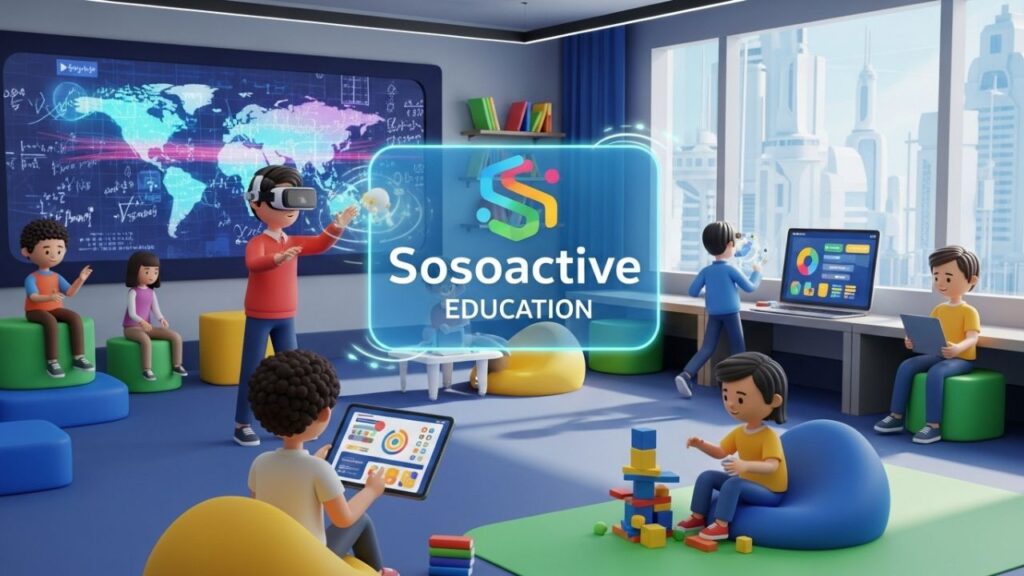Introduction
In a world undergoing rapid technological change, the phrase sosoactive education captures a new approach to learning — one that combines interaction, technology and active student participation. With sosoactive education, learners don’t simply absorb information; they engage, explore and co-create knowledge. In this article, we’ll delve into what sosoactive education really means, its driving forces, the benefits it brings, its challenges, and how educators and students can make the most of it.
What Is sosoactive education?
sosoactive education refers to a learning model that moves beyond passive lectures and rote memorisation. Instead, this model emphasises active involvement, real-time interaction, technology integration, and personalised learning paths. According to recent coverage, this approach also harnesses tools like virtual or augmented reality, adaptive analytics, and online collaboration.
At its heart, sosoactive education is built around three major pillars:
-
Active Engagement: Students are encouraged to participate meaningfully through discussions, projects or simulations.
-
Technology Integration: Digital platforms, data-driven feedback and immersive tools become part of everyday learning.
-
Personalised Learning: Content and pace adapt to each student’s needs and learning style.
These features combine to create a dynamic learning environment where the learner is at the centre rather than the curriculum alone.
Why sosoactive education Matters Today
The Changing Educational Landscape
Today’s learners face a very different environment compared to previous generations: information is abundant, attention spans are shorter, and skills such as critical thinking and collaboration are increasingly important. The traditional model of teacher-led instruction is less suited to these demands. Hence, sosoactive education steps in to bridge that gap.
Relevance to 21st-Century Skills
In the job market and life beyond school, students are expected to handle ambiguity, work in teams, adapt to new tools, and solve problems creatively. sosoactive education supports these outcomes by fostering interactive learning experiences rather than passive ones.
Technology as an Enabler
With tools like learning-management systems (LMS), virtual classrooms, AI tutors, AR/VR simulations and analytics, the logistics of personalised, engaging learning are increasingly feasible. The reference I found states: “It uses smart tools like … VR/AR … cloud-based platforms.”
So, the importance of sosoactive education lies not just in novelty, but in its alignment with modern demands of learners, educators and society at large.
Key Principles of sosoactive education
In practice, there are several guiding principles that separate sosoactive education from more traditional models:
1. Learner-Centred Design
Rather than teacher-centred lectures, the focus is on what each student brings and how they can actively engage. Lessons are built around inquiry, problem-solving and collaboration.
2. Technology-Augmented Learning
From interactive simulations to real-time feedback dashboards, technology plays a supportive and enhancing role—not just a novelty. According to one source, “It uses smart tools like … AI … cloud-based platforms.”
3. Continuous Feedback and Adaptation
In sosoactive education, the cycle of teaching → doing → feedback is tighter. Students receive timely feedback, enabling them to adjust and deepen their understanding continuously.
4. Collaboration and Social Learning
Group work, peer interaction and collaborative digital tasks are central. Learning is not siloed; it is communal and interactive.
5. Flexibility and Personalisation
Different learners have different paths. The model recognises this and offers flexibility in pace, sequence and even method of learning.
Benefits of sosoactive education
Adopting sosoactive education brings several tangible benefits for learners, educators and institutions alike.
Improved Engagement
Interactive tasks and immersive tools make lessons more interesting and relevant, thereby improving attention and motivation. As noted, “Interactive lessons hold attention longer and make complex topics easier to understand.”
Better Retention and Understanding
When students actively participate rather than passively listen, they tend to retain information more deeply, understand concepts rather than just memorise, and transfer knowledge to new situations.
Development of Soft Skills
Teamwork, communication, critical thinking, digital literacy and self-regulation are all cultivated in a sosoactive education environment, helping prepare students for real-world challenges.
Personalised Learning Pathways
Learners can progress at their own pace, receive customised content or support, which helps cater to diverse needs and prevents students from falling behind or becoming disengaged.
Teacher Empowerment
Rather than being the “sage on the stage”, educators become facilitators, mentors and designers of rich learning experiences. This change can enhance teacher-satisfaction and effectiveness.
Implementation Challenges of sosoactive education
While promising, adopting sosoactive education is not without its challenges. The key ones include:
Access to Technology
Not all students or institutions have access to high-speed internet, devices or immersive tools like VR. This digital divide can hinder equal implementation.
Professional Development for Teachers
Teachers need training not just in technology, but in designing interactive tasks, facilitating collaborative learning and interpreting analytics. Many may need to shift mindset and practices.
Cost and Infrastructure
Acquiring, maintaining and updating the tools required for sosoactive education may involve significant cost, especially for under-resourced schools or regions.
Screen Time and Distraction Concerns
Heavy reliance on screens and digital tools can raise concerns over student well-being, distraction, and healthy learning habits. Balanced use is essential.
Change Management
Shifting to this approach often requires rethinking curriculum, assessment methods, classroom layout and institutional culture. Resistance or inertia may slow adoption.
Best Practices for Making sosoactive education Work
If you’re an educator, institution or student wanting to embrace sosoactive education, the following strategies can help:
Start Small and Iterate
Begin with pilot projects—interactive modules, flipped classrooms, group-based digital tasks—and gather feedback. Use what works and build gradually.
Prioritise Professional Development
Invest in teacher training around digital tools, collaborative pedagogy and data-driven instruction. Empower teachers to become designers of active learning.
Ensure Access and Equity
Consider alternative access solutions for students with limited technology (e.g., shared devices, offline resources, blended learning). Equity must be a priority.
Design Engaging Activities, Not Just Tools
Technology is an enabler but the activity design matters. Projects, simulations, peer discussions and authentic tasks drive success in sosoactive education.
Monitor, Reflect and Adjust
Use analytics and student feedback to monitor engagement, learning outcomes and tool effectiveness. Be prepared to tweak approaches as you learn.
Blend Tech with Human Connection
Even a tech-rich environment needs human connection—teacher mentoring, peer interaction, social learning. The human element remains central in sosoactive education.
The Future of sosoactive education
Looking ahead, sosoactive education is poised to continue evolving, with trends such as:
-
Global Collaboration: Students from different regions learning together virtually, expanding cultural exposure and shared inquiry.
-
AI Tutors & Adaptive Learning: Systems that personalise in real-time for each learner based on performance, style and preference.
-
Immersive Simulations: AR/VR experiences that turn abstract or remote concepts into hands-on, lifelike simulations.
-
Sustainable Digital Models: Reducing reliance on paper, increasing access with cloud-based tools, moving toward more eco-friendly education structures.
-
Lifelong Learning Integration: As career spans lengthen, sosoactive education could extend into adult learning, micro-credentials and flexible modular pathways.
These directions underscore that sosoactive education is not merely a fad—it represents an evolving model of how humans learn in the digital age.
Conclusion
sosoactive education offers a compelling vision of what learning can become: active, technology-rich, personalised and collaborative. It challenges old models where students passively receive information and instead invites them into environments where they contribute, create and take ownership of their learning. While implementation has its obstacles—technology access, professional development, cost and change management—the benefits for learners and educators are significant. As schools and organisations invest wisely in this model, the gains in engagement, retention, skill development and relevance promise to be transformative.
In short: if you’re looking at how to future-proof learning in your classroom, institution or personal journey, is a concept worth embracing. It’s not just about using tech—it’s about learning that’s alive, meaningful and built for the digital era.





